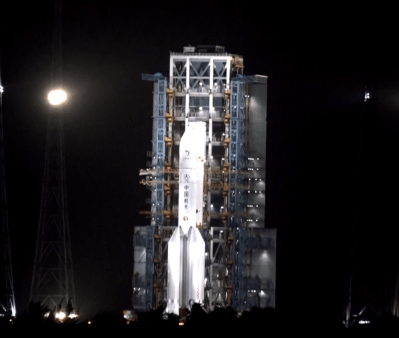Sure, the SpaceX crew made it safely to the ISS, but there’s plenty happening beyond just that particular horizon. The Chinese National Space Administration have launched their Chang’e 5 mission to collect and return lunar rock samples, a collaboration between NASA and ESA to do the same with samples from Mars has passed its review, and a pair of satellites came uncomfortably close to each other in a near-miss that could have had significant orbital debris consequences. It’s time for Spacing Out!
Bringing Alien Rocks to Earth

Ever since the NASA and Soviet lunar launches at the height of the Space Race, there have been no new missions to collect material from the Lunar surface and return it to Earth. That changed last week.
The Chang’e 5 mission launched in China on November 23rd will deliver moon rocks to earth, and as this is being written it has already entered Lunar orbit and separated into its constituent parts in preparation for landing. It’s a four-craft mission, with a lunar lander and ascent module going to the surface, and a service module and Earth return craft remaining in orbit to receive the samples and send them back to the planet for re-entry and retrieval. The hurdles facing the mission scientists and engineers are immense, and a safe sample return in mid-December will be an extremely impressive achievement.
Happily Chang’e 5 even has a hacker angle, as its telemetry has offered a bonanza to satellite-watchers who have turned their dishes skyward to capture the event. Daniel Estévez EA4GPZ has posted a collected analysis of data telemetry work by a variety of people worldwide, but the eye-candy prize goes to r00t.cz, who has successfully decoded image stream data to the extent that they have assembled a fragment of video captured from the craft during its journey.
Not to be outdone in the field of ambitious sample return missions, NASA and ESA’s joint plan to collect and return rock core samples from Mars has met with the approval of the independent review board set up to examine it. This will involve multiple craft from both agencies, with NASA’s already launched Perseverance rover collecting and containing the samples before leaving them on the surface for eventual collection by a future ESA rover. This will then pass them to a NASA ascent craft which will take them to Martian orbit and rendezvous with an ESA craft that will return them to Earth. We space-watchers are in for an exciting decade.
That Was a Close One!
Anyone who has seen the film Gravity will be familiar with the Kessler syndrome, in which collisions between spacecraft and or debris could create a chain reaction of further collisions and render entire orbital spheres unusable to future craft because of the collision hazard presented by the resulting cloud of space debris. Because of this, spacecraft operators devote considerable resources towards avoiding such collisions, and it is not uncommon for slight orbital adjustments to be made to avoid proximity with other orbiting man-made objects.
On the 27th of November it seems that these efforts failed, with a terse announcement from Roscosmos of a near-miss between their Kanopus-V craft and the Indian CARTOSAT 2F. The two remote-imaging satellites passed as close as 224 metres from each other, which in space terms given their likely closing speeds would have been significantly too close for comfort. The announcement appears worded to suggest that the Indian craft was at fault, however it’s probably a fairer conclusion that both space agencies should have seen the other’s satellite coming. Fortunately we escaped a catastrophe this time, but it is to be hoped that all operators of such satellites will take note.
RocketLab Joins the Reusable Booster Club
Other recent launches that might excite the interest of readers are the New Zealand-based RocketLab launching their Electron rocket with 30 small satellites on board before for the first time retrieving their booster stage, and the Japanese Mitsubish Electric sending their JDRS-1 satellite to geosynchronous orbit. This last craft is of interest because it carries an optical data link rather than the more usual RF, and could prove the technology for future launches.
The coming weeks should be full of news from China on Chang’e 5’s progress. Getting a craft to the moon and returning it will be a huge achievement, and we hope nothing fails and we’ll see pictures of the first new Moon rocks on Earth since the 1970s. We don’t know how to say “Good luck and a successful mission!” in Chinese, so we’ll say it in English.











